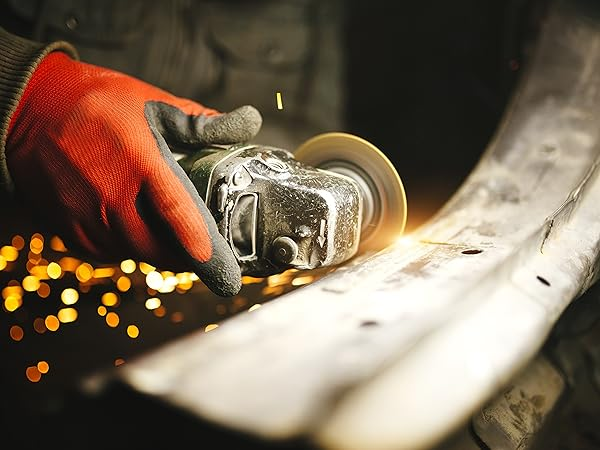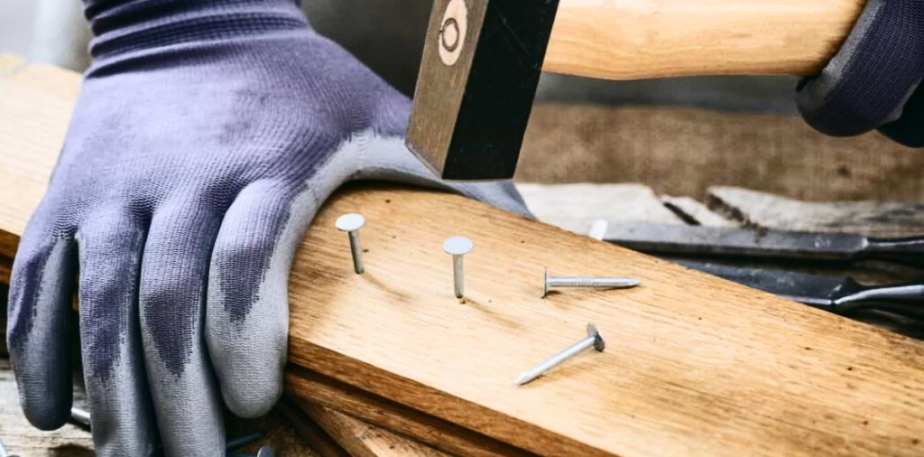Whether you’re a seasoned expert or just starting out in woodworking and carpentry, there’s no doubt that protecting your hands is essential. Working with sharp tools or handling heavy materials can easily result in injury if you’re not careful. That’s why wearing gloves for adequate hand protection is crucial. Next, we’ll provide a comprehensive overview of several common types of gloves suitable for woodworking, ensuring you can work with ease and safety.

Cut-Resistant Gloves
Cut-resistant gloves are specifically designed to prevent hand injuries from sharp objects such as blades, glass, or cutting machines. They are typically made from high-strength fibers such as Kevlar, HPPE, or stainless steel wire.
Advantages
- Woodworkers often use sharp tools like saws, chisels, planes, and utility knives. One wrong move can easily lead to cuts. Cut-resistant gloves effectively prevent such accidental injuries.
- Rough wood, splinters, and sawdust can easily pierce the skin. These gloves protect against such punctures.
- The edges of cut wood often have burrs or splinters. Handling them bare-handed can lead to cuts, but gloves allow for safe handling.
- When using power tools like saws, planers, or drills, vibration or hand slips can cause accidents. Cut-resistant gloves provide a crucial barrier at such moments, reducing injury risks.
Disadvantages
- Due to the use of materials like HPPE, Kevlar, or stainless-steel blends, finger flexibility is reduced, making these gloves unsuitable for delicate tasks such as carving, sanding, or precise assembly.
- Most cut-resistant gloves sacrifice breathability for density and protection, leading to sweating and discomfort during extended wear—especially in summer or during intense labor.
- Some gloves are thick or have stiff coatings, making it harder to handle tools like screwdrivers or carving knives.
- High-level cut-resistant gloves are significantly more expensive than regular work gloves, which may be a financial burden for small woodworking shops or individual workers.
- If the glove material gets caught in a power saw or drill, it may worsen the injury or cause equipment malfunction.
Uses
Cut-resistant gloves are suitable for tasks involving hand saws, carving tools, wood planes, and general material handling or rough processing in woodworking.

Nitrile-Coated Gloves
Nitrile-coated gloves are made by knitting lightweight fabrics like cotton, polyester, or nylon, and then dipping the palm and fingers in nitrile synthetic rubber.
Advantages
- Nitrile offers excellent slip resistance, especially in handling wet or resin-coated wood, glue-covered parts, or polishing tools, reducing the risk of accidents from slippage.
- Woodworkers often use materials like wood wax oil, glue, cleaners, and resins. Nitrile is resistant to chemicals and prevents damage from exposure.
- Compared to PU, nitrile coatings are thicker, more wear- and puncture-resistant, and better suited for handling rough wood, splinters, and sharp edges. Ideal for using power tools, cutting panels, or applying adhesives.
- Nitrile gloves offer soft and elastic comfort, balancing protection and flexibility, making them suitable for long periods of use.
Disadvantages
- Nitrile coatings are thicker and less flexible than PU or ultra-thin coatings, reducing fingertip sensitivity during detailed tasks like carving or precise nailing.
- Nitrile lacks breathability—especially in fully-coated gloves—causing sweaty, uncomfortable hands over time, which can affect safety and comfort.
- When working in high temperatures (e.g., grinding), nitrile can soften or degrade and is not suitable for heat-intensive tasks.
- Nitrile gloves are slightly heavier than PU or textile gloves, which may cause hand fatigue during prolonged continuous work.
- Nitrile becomes hard and loses flexibility in cold environments, making it unsuitable for extreme or freezing conditions.
Uses
Nitrile-coated gloves are ideal for handling wooden panels, applying glue or wood wax oil, using drills or sanders, and rough cutting or grinding tasks in woodworking.

PU-Coated Gloves
PU-coated gloves are made by knitting lightweight fabrics such as cotton, polyester, or nylon, then dipping the palm and fingertips in polyurethane (PU).
Advantages
- PU coatings are extremely thin and provide excellent fingertip dexterity and tactile feedback, making them ideal for tasks requiring precision, such as carving, joining, nailing, sanding, and installation.
- The PU surface offers excellent grip, especially for smooth, dry, or slightly damp wood and tools, reducing slippage and improving operational safety.
- Though thin, PU coatings are wear-resistant enough to protect hands during repetitive handling of wood or contact with sharp edges.
- These gloves usually feature elastic knitted backs with coated palms, offering both breathability and a snug fit—ideal for prolonged wear without sweat buildup or slippage.
Disadvantages
- Despite their abrasion resistance, PU gloves are thin and offer minimal protection against wood splinters, blades, or saw teeth during handling or cutting tasks.
- PU gloves are suited for fine work but wear out faster in heavy-duty or high-friction environments.
- PU coatings degrade under high heat, becoming sticky or soft, making them unsuitable for contact with hot woodworking tools or materials.
- These gloves don’t absorb shock from hammering or vibrating power tools and lack padding, offering little protection to joints.
Uses
PU-coated gloves are ideal for woodworking tasks such as carving, assembly, installation, nailing, sanding, trimming, and furniture assembly or finishing.

Cotton Gloves
Cotton gloves are mainly knitted from pure or blended cotton yarn. Some versions feature added PVC dots, latex, or other coatings on the palm to enhance grip and durability.
Advantages
- Useful when handling rough wood, panels, or frames, preventing cuts from wood chips or burrs.
- Their sweat-absorbing quality helps keep hands dry during long or hot work sessions, improving grip and reducing tool slippage.
- In dusty woodworking environments, these gloves protect hands from fine particles like sawdust—especially useful during cutting, sanding, or cleaning.
- Cotton gloves buffer pressure and friction during repetitive handling or manual operations, reducing palm fatigue.
- They are low-cost, reusable, and suitable for bulk provision in woodworking factories or furniture workshops.
Disadvantages
- Cotton yarn gloves offer almost no protection against sharp objects like splinters, saw teeth, or carving tools and can be easily pierced or torn.
- They have poor grip on smooth, dusty, or moist surfaces, posing operational risks.
- Cotton material absorbs wood chips, dust, and oil, making them hard to clean and prone to bacteria or odors over time.
- Not resistant to heat, sparks, or chemicals like paint or glue, and may be damaged or pose hazards if exposed to flammable or corrosive substances.
Uses
Cotton yarn gloves are suitable for initial wood handling, surface sanding/dusting, assisting in assembly, light polishing or deburring, and sorting tools or small parts.

Conclusion
There are various types of gloves used in woodworking, and the ones above are among the most common. The best choice depends on your specific needs. If you want to learn more about gloves suitable for woodworking, feel free to contact us—we are available 24/7 to assist you.
How to Measure Glove Sizes – Source: AIBON
Latex gloves– Source: AIBON
Safety gloves– Source: AIBON
Working gloves– Source: AIBON

